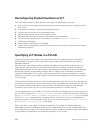Keep the following points in mind when you configure VLT nodes in a PVLAN:
• Configure the VLTi link to be in trunk mode. Do not configure the VLTi link to be in access or
promiscuous mode.
• You can configure a VLT LAG or port channel to be in trunk, access, or promiscuous port modes
when you include the VLT LAG in a PVLAN. The VLT LAG settings must be the same on both the peers.
If you configure a VLT LAG as a trunk port, you can associate that LAG to be a member of a normal
VLAN or a PVLAN. If you configure a VLT LAG to be a promiscuous port, you can configure that LAG
to be a member of PVLAN only. If you configure a VLT LAG to be in access port mode, you can add
that LAG to be a member of the secondary VLAN only.
• ARP entries are synchronized even when a mismatch occurs in the PVLAN mode of a VLT LAG.
Any VLAN that contains at least one VLT port as a member is treated as a VLT VLAN. You can configure a
VLT VLAN to be a primary, secondary, or a normal VLAN. However, the VLT VLAN configuration must be
symmetrical across peers. If the VLT LAG is tagged to any one of the primary or secondary VLANs of a
PVLAN, then both the primary and secondary VLANs are considered as VLT VLANs.
If you add an ICL or VLTi link as a member of a primary VLAN, the ICL becomes a part of the primary
VLAN and its associated secondary VLANs, similar to the behavior for normal trunk ports. VLAN parity is
not validated if you associate an ICL to a PVLAN. Similarly, if you dissociate an ICL from a PVLAN,
although the PVLAN parity exists, ICL is removed from that PVLAN.
Association of VLTi as a Member of a PVLAN
If a VLAN is configured as a non-VLT VLAN on both the peers, the VLTi link is made a member of that
VLAN if the VLTi link is configured as a PVLAN or normal VLAN on both the peers. If a PVLAN is
configured as a VLT VLAN on one peer and a non-VLT VLAN on another peer, the VLTi is added as a
member of that VLAN by verifying the PVLAN parity on both the peers. In such a case, if a PVLAN is
present as a VLT PVLAN on at least one of the peers, then symmetric configuration of the PVLAN is
validated to cause the VLTi to be a member of that VLAN. Whenever a change in the VLAN mode on one
of the peers occurs, the information is synchronized with the other peer and VLTi is either added or
removed from the VLAN based on the validation of the VLAN parity.
For VLT VLANs, the association between primary VLAN and secondary VLANs is examined on both the
peers. Only if the association is identical on both the peers, VLTi is configured as a member of those
VLANs. This behavior is because of security functionalities in a PVLAN. For example, if a VLAN is a primary
VLT VLAN on one peer and not a primary VLT VLAN on the other peer, VLTi is not made a part of that
VLAN.
MAC Synchronization for VLT Nodes in a PVLAN
For the MAC addresses that are learned on non-VLT ports, MAC address synchronization is performed
with the other peer if the VLTi (ICL) link is part of the same VLAN as the non-VLT port. For MAC addresses
that are learned on VLT ports, the VLT LAG mode of operation and the primary to secondary association
of the VLT nodes is determined on both the VLT peers. MAC synchronization is performed for the VLT
LAGs only if the VLT LAG and primary-secondary VLT peer mapping are symmetrical.
The PVLAN mode of VLT LAGs on one peer is validated against the PVLAN mode of VLT LAGs on the
other peer. MAC addresses that are learned on that VLT LAG are synchronized between the peers only if
the PVLAN mode on both the peers is identical. For example, if the MAC address is learned on a VLT LAG
Virtual Link Trunking (VLT)
985


















